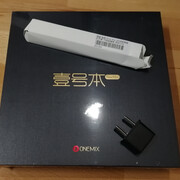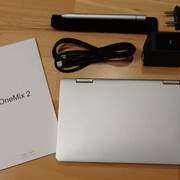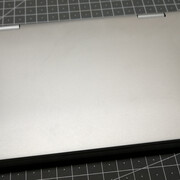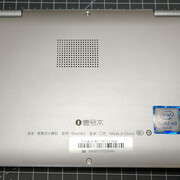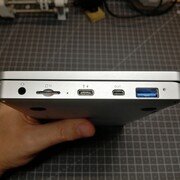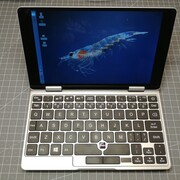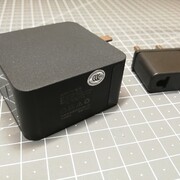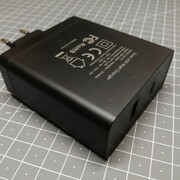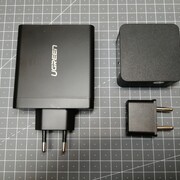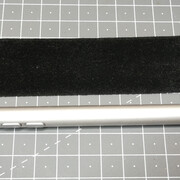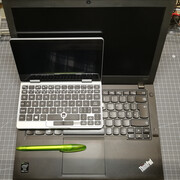One-Mix Yoga 2
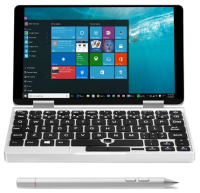 I'm a big fan of tiny portable computers and still fondly remember my EeePC. Unfortunately the NetBooks fell out of fashion again and for a long time it was hard to get any really small laptops. But it seems the genre is coming back under the name “Ultra-Mobile PC” or UMPC.
I'm a big fan of tiny portable computers and still fondly remember my EeePC. Unfortunately the NetBooks fell out of fashion again and for a long time it was hard to get any really small laptops. But it seems the genre is coming back under the name “Ultra-Mobile PC” or UMPC.
The start made the somewhat under powered GPD Pocket, followed up by an even worse One-Mix Yoga. However both had very successful crowd funding campaigns which proved there is a demand for small computers. Both, GPD and One-Mix are Chinese companies designing, building and selling these machines in seemingly small batches with the initial production funded by crowd founding. This allows them relatively quick iterations.
Last year finally the GPD Pocket 2 was released which improved a lot on the first design and shortcomings and One-Mix followed suit just a few months ago with the Yoga 2.
I decided to get the Yoga 2 because of the slightly more powerful specs (more on that later). I bought it at Geekbuying for 559.30€ including shipping. As a pleasant surprise, the device got shipped from the Netherlands instead of directly from China so had not to pay any additional tolls and taxes.
Below follows a long post (you have been warned) about the hardware in it and how to get it running on Arch Linux with XFCE.
Hardware
The general specs for the One Mix Yoga 2 are as follows:
- Intel Core m3-7Y30 CPU
- Intel HD Graphics 615
- 8GB DDR3 RAM
- 256GB PCI-E SSD
- 7“ Touchscreen with 1200×1920 Resolution (324ppi) with Stylus Support
The device weighs about 515g and measures 182x110x17mm. It is absolutely tiny! It has a machined aluminum body and looks really good. Even the packaging it comes in look gorgeous.
For connectors it comes with a 3.5mm headset connector, a single USB 3.0 port, a USB-C port that also is used for charging and a Micro HDMI port. It also has a builtin SD-card reader and a fingerprint sensor. An optical sensor works as a mouse/trackpoint. It has builtin 2.4G and 5G WiFi and Bluetooth.
The Yoga 2 comes with a USB-C PD charger with a UK-Plug. Geekbuying added a flimsy little adapter to the EU-Standard. Unfortunately this combination did not work and I bought my own one. When you buy a charger you have to be careful, according to reports by others the laptop charges with 12V only (at 2.5A). Many USB-C PD chargers switch from 9V directly to 15V and do not support the 12V step. I bought an UGreen CD172 57 Watts charger which works great even though it does not list the 12V output on the label. What I don't like is that is much bulkier than the original charger.
I was curious if the charger or the adapter is broken and used my travel adapter instead. Turns out the little adapter plug is broken and the charger works just fine. Opening up the adapter showed that it is really quite simple. There is no electronics, not even a fuse. There is really nothing that can be broken except when a contact isn't there. After screwing it back together it worked fine. I guess I have two chargers now 
According to the manufacturer the (non-swappable) 6500mAh battery should last about 12 hours, which is of course bullshit. In my experience about 4 to 6 hours battery life is more realistic. However there's a way to throttle the CPU by pressing FN+ESC. One-Mix calls it “quiet-mode” as it avoids spinning up the very audible fan.
As you can see from the 1200×1900 resolution, the full-HD screen's natural orientation is actually portrait mode. The pre-installed Windows 10 and the Bios settings know about this and rotate their screens accordingly. For the following Linux setup this has to be taken care of.
For turning the laptop on, the power button needs to be held for a couple of seconds. The LED on the right hand side turns blue when the laptop is running and red when charging. When suspended the LED blinks in red.
The keyboard is only available in US-Layout and of course is a little cramped. However I found it fine to use. I mostly have problems hitting Q when I meant to use the Tab key. All other key positions are fine by my book.
Pictures
Hardware as identified in Linux
Before we start, here is how all the hardware is identified by various hardware query tools on the running Arch Linux setup.
$ lspci 00:00.0 Host bridge: Intel Corporation Xeon E3-1200 v6/7th Gen Core Processor Host Bridge/DRAM Registers (rev 02) 00:02.0 VGA compatible controller: Intel Corporation Device 591e (rev 02) 00:04.0 Signal processing controller: Intel Corporation Xeon E3-1200 v5/E3-1500 v5/6th Gen Core Processor Thermal Subsystem (rev 02) 00:08.0 System peripheral: Intel Corporation Xeon E3-1200 v5/v6 / E3-1500 v5 / 6th/7th Gen Core Processor Gaussian Mixture Model 00:14.0 USB controller: Intel Corporation Sunrise Point-LP USB 3.0 xHCI Controller (rev 21) 00:14.2 Signal processing controller: Intel Corporation Sunrise Point-LP Thermal subsystem (rev 21) 00:15.0 Signal processing controller: Intel Corporation Sunrise Point-LP Serial IO I2C Controller #0 (rev 21) 00:15.1 Signal processing controller: Intel Corporation Sunrise Point-LP Serial IO I2C Controller #1 (rev 21) 00:15.2 Signal processing controller: Intel Corporation Sunrise Point-LP Serial IO I2C Controller #2 (rev 21) 00:16.0 Communication controller: Intel Corporation Sunrise Point-LP CSME HECI #1 (rev 21) 00:1c.0 PCI bridge: Intel Corporation Sunrise Point-LP PCI Express Root Port #7 (rev f1) 00:1d.0 PCI bridge: Intel Corporation Sunrise Point-LP PCI Express Root Port #9 (rev f1) 00:1e.0 Signal processing controller: Intel Corporation Sunrise Point-LP Serial IO UART Controller #0 (rev 21) 00:1e.4 SD Host controller: Intel Corporation Device 9d2b (rev 21) 00:1e.6 SD Host controller: Intel Corporation Sunrise Point-LP Secure Digital IO Controller (rev 21) 00:1f.0 ISA bridge: Intel Corporation Sunrise Point-LP LPC Controller (rev 21) 00:1f.2 Memory controller: Intel Corporation Sunrise Point-LP PMC (rev 21) 00:1f.3 Audio device: Intel Corporation Sunrise Point-LP HD Audio (rev 21) 00:1f.4 SMBus: Intel Corporation Sunrise Point-LP SMBus (rev 21) 01:00.0 Non-Volatile memory controller: Device 1d97:1160 (rev b0) 02:00.0 Network controller: Intel Corporation Wireless 3165 (rev 81)
$ lsusb Bus 002 Device 001: ID 1d6b:0003 Linux Foundation 3.0 root hub Bus 001 Device 004: ID 2808:9338 Bus 001 Device 003: ID 8087:0a2a Intel Corp. Bus 001 Device 002: ID 258a:0021 Bus 001 Device 001: ID 1d6b:0002 Linux Foundation 2.0 root hub
$ sudo lshw -short
H/W path Device Class Description
=================================================
system Default string (Default string)
/0 bus Default string
/0/0 memory 64KiB BIOS
/0/35 memory 8GiB System Memory
/0/35/0 memory 4GiB Row of chips LPDDR3 Synchronous Unbuffered (Unregistered) 1600 MHz (0.6 ns)
/0/35/1 memory 4GiB Row of chips LPDDR3 Synchronous Unbuffered (Unregistered) 1600 MHz (0.6 ns)
/0/39 memory 128KiB L1 cache
/0/3a memory 512KiB L2 cache
/0/3b memory 4MiB L3 cache
/0/3c processor Intel(R) Core(TM) m3-7Y30 CPU @ 1.00GHz
/0/100 bridge Xeon E3-1200 v6/7th Gen Core Processor Host Bridge/DRAM Registers
/0/100/2 display Intel Corporation
/0/100/4 generic Xeon E3-1200 v5/E3-1500 v5/6th Gen Core Processor Thermal Subsystem
/0/100/8 generic Xeon E3-1200 v5/v6 / E3-1500 v5 / 6th/7th Gen Core Processor Gaussian Mixture Model
/0/100/14 bus Sunrise Point-LP USB 3.0 xHCI Controller
/0/100/14/0 usb1 bus xHCI Host Controller
/0/100/14/0/2 input USB KEYBOARD
/0/100/14/0/7 communication Bluetooth wireless interface
/0/100/14/0/9 generic FT9201Fingerprint.
/0/100/14/1 usb2 bus xHCI Host Controller
/0/100/14.2 generic Sunrise Point-LP Thermal subsystem
/0/100/15 generic Sunrise Point-LP Serial IO I2C Controller #0
/0/100/15.1 generic Sunrise Point-LP Serial IO I2C Controller #1
/0/100/15.2 generic Sunrise Point-LP Serial IO I2C Controller #2
/0/100/16 communication Sunrise Point-LP CSME HECI #1
/0/100/1c bridge Sunrise Point-LP PCI Express Root Port #7
/0/100/1c/0 storage Non-Volatile memory controller
/0/100/1d bridge Sunrise Point-LP PCI Express Root Port #9
/0/100/1d/0 wlp2s0 network Wireless 3165
/0/100/1e generic Sunrise Point-LP Serial IO UART Controller #0
/0/100/1e.4 generic Intel Corporation
/0/100/1e.6 generic Sunrise Point-LP Secure Digital IO Controller
/0/100/1f bridge Sunrise Point-LP LPC Controller
/0/100/1f.2 memory Memory controller
/0/100/1f.3 multimedia Sunrise Point-LP HD Audio
/0/100/1f.4 bus Sunrise Point-LP SMBus
/1 power To Be Filled By O.E.M.
$ lsblk NAME MAJ:MIN RM SIZE RO TYPE MOUNTPOINT mmcblk1 179:0 0 28.8G 0 disk nvme0n1 259:0 0 238.5G 0 disk ├─nvme0n1p1 259:1 0 512M 0 part /boot └─nvme0n1p2 259:2 0 238G 0 part /
$ upower -i /org/freedesktop/UPower/devices/battery_BAT0
native-path: BAT0
vendor: Intel SR 1
model: SR Real Battery
serial: 123456789
power supply: yes
updated: Thu 03 Jan 2019 12:30:10 PM CET (119 seconds ago)
has history: yes
has statistics: yes
battery
present: yes
rechargeable: yes
state: discharging
warning-level: none
energy: 30.9 Wh
energy-empty: 0 Wh
energy-full: 34.08 Wh
energy-full-design: 32 Wh
energy-rate: 1.824 W
voltage: 7.7 V
time to empty: 16.9 hours
percentage: 90%
capacity: 100%
icon-name: 'battery-full-symbolic'
$ xrandr --query Screen 0: minimum 8 x 8, current 1920 x 1200, maximum 32767 x 32767 eDP1 connected primary 1920x1200+0+0 right (normal left inverted right x axis y axis) 94mm x 151mm 1200x1920 59.98*+ 1024x768 60.00 1024x576 59.90 59.82 600x960 60.00 960x540 59.63 59.82 800x600 60.32 56.25 864x486 59.92 59.57 640x480 59.94 720x405 59.51 58.99 640x360 59.84 59.32 DP1 disconnected (normal left inverted right x axis y axis) HDMI1 disconnected (normal left inverted right x axis y axis) HDMI2 disconnected (normal left inverted right x axis y axis) VIRTUAL1 disconnected (normal left inverted right x axis y axis)
$ hwinfo --short
cpu:
Intel(R) Core(TM) m3-7Y30 CPU @ 1.00GHz, 1100 MHz
Intel(R) Core(TM) m3-7Y30 CPU @ 1.00GHz, 1066 MHz
Intel(R) Core(TM) m3-7Y30 CPU @ 1.00GHz, 1100 MHz
Intel(R) Core(TM) m3-7Y30 CPU @ 1.00GHz, 1100 MHz
keyboard:
/dev/input/event8 HAILUCK CO.,LTD USB KEYBOARD
/dev/input/event4 AT Translated Set 2 keyboard
mouse:
/dev/input/mice HAILUCK CO.,LTD USB KEYBOARD
/dev/input/mice Goodix Capacitive TouchScreen
graphics card:
Intel VGA compatible controller
sound:
Intel Audio device
storage:
Non-Volatile memory controller
network:
wlp2s0 Intel Wireless 3165
network interface:
lo Loopback network interface
wlp2s0 Ethernet network interface
disk:
/dev/nvme0n1 Disk
/dev/mmcblk1 Disk
partition:
/dev/nvme0n1p1 Partition
/dev/nvme0n1p2 Partition
usb controller:
Intel Sunrise Point-LP USB 3.0 xHCI Controller
bios:
BIOS
bridge:
Intel Sunrise Point-LP PCI Express Root Port #7
Intel ISA bridge
Intel Host bridge
Intel Sunrise Point-LP PCI Express Root Port #9
hub:
Linux Foundation 2.0 root hub
Linux Foundation 3.0 root hub
memory:
Main Memory
bluetooth:
Intel Bluetooth Device
unknown:
FPU
DMA controller
PIC
Keyboard controller
Intel Sunrise Point-LP PMC
Intel Skylake Gaussian Mixture Model
Intel Sunrise Point-LP Serial IO I2C Controller #1
Intel Sunrise Point-LP Secure Digital IO Controller
Intel SD Host controller
Intel Skylake Processor Thermal Subsystem
Intel Sunrise Point-LP CSME HECI #1
Intel Sunrise Point-LP Serial IO UART Controller #0
Intel Sunrise Point-LP Serial IO I2C Controller #2
Intel 100 Series PCH/Sunrise Point PCH I2C0 [Skylake/Kaby Lake LPSS I2C]
Intel Sunrise Point-LP Thermal subsystem
Intel Sunrise Point-LP SMBus
Focal-systems.Corp FT9201Fingerprint.
Arch Linux Base Setup
Besides the official Arch Linux Installation Guide, I basically followed guides by github user joshskidmore and Reddit user mogen317 for the similar GPD Pocket 2.
The difference is that the Yoga 2 has a faster NVMe SSD, which results in a different block device name and I did not bother with setting up encryption or keeping Windows.
Please also refer to the three linked guides above and make sure you understand what your'e doing when folling my notes here. I assume this is not your first Arch install.
The Yoga 2 only supports UEFI booting, which is more modern but also a bit more mysterious to me (being an old fart). Anyway, download the latest Arch ISO and flash it to an USB stick. Insert the stick and hold FN-F7 when booting the machine to bring up the boot menu.
Once you're in the shell, rotate the screen:
echo 1 > /sys/class/graphics/fbconv/rotate_all
Next, connect to WiFi:
wifi-menu systemctl restart dhcpcd.service ping google.com
Partition the disk using
gdisk /dev/nvme0n1
We create only two partitions: EFI and our root file system.
o ↵ to create a new empty GUID partition table (GPT) y ↵ to confirm n ↵ add a new partition ↵ to select default partition number of 1 ↵ to select default start at first sector +512M ↵ make that size partition for booting ef00 ↵ Partition type EFI n ↵ to add new partition ↵ to select default partition number of 2 ↵ to select default start of sector ↵ to select default end of sector 8300 ↵ to make partition type for linux p ↵ if you want to check the partition layout w ↵ to write changes to disk y ↵ to confirm
Next create the filesystem for both partitions:
mkfs.fat -F32 /dev/nvme0n1p1 mkfs.ext4 /dev/nvme0n1p2
Then mount the new partitions, bootstrap the first packages and create the fstab:
mount /dev/nvme0n1p2 /mnt mkdir /mnt/boot mount /dev/mmcblk0p1 /mnt/boot pacstrap /mnt base base-devel dialog openssl-1.0 bash-completion git intel-ucode wpa_supplicant genfstab -pU /mnt >> /mnt/etc/fstab
Time to chroot into the new system, create the init disk and install the bootloader:
arch-chroot /mnt /bin/bash mkinitcpio -P bootctl install
Next we need to create bunch of files.
Set the hostname:
- /etc/hostname
krill
Set a somewhat larger console font:
- /etc/vconsole.conf
FONT=latarcyrheb-sun32
Prepare the boot loader:
- /boot/loader/entries/arch.conf
title Arch Linux linux /vmlinuz-linux initrd /intel-ucode.img initrd /initramfs-linux.img options root=/dev/nvme0n1p2 rw fbcon=rotate:1
- /boot/loader/loader.conf
timeout 3 default arch console-mode keep
Prepare the locales
- /etc/locale.conf
LANG=en_US.UTF-8 LANGUAGE=en_US LC_ALL=C
- /etc/locale.gen
en_US.UTF-8 UTF-8
Finally we set the timezone, generate the locales, set a root password and create the first user.
ln -sf /usr/share/zoneinfo/Europe/Berlin /etc/localtime systemctl enable systemd-timesyncd.service systemctl start systemd-timesyncd.service locale-gen passwd useradd -m -U -G wheel,storage,power -s /bin/bash andi passwd andi
Time to reboot
exit umount -R /mnt # Remove USB stick and reboot reboot
You should now have a minimal, console-only Arch Linux running.
Power Management
To enable power management and overheat protection, install thermald and tlp. The default configs should suffice.
pacman -S thermald sudo systemctl enable thermald.service sudo systemctl start thermald.service pacman -S tlp sudo systemctl enable tlp sudo systemctl start tlp
User Groups
You may or may not need to add your user to a handful of additional groups. If you run into trouble later on try these groups:
sudo usermod -a -G lp andi sudo usermod -a -G rfkill andi sudo usermod -a -G users andi sudo usermod -a -G video andi sudo usermod -a -G audio andi sudo usermod -a -G network andi
X and XFCE
Time to get the graphics going. Install the packages (accept the defaults for the meta packages).
pacman -S xorg xf86-video-intel mesa xfce4 xfce4-goodies lightdm lightdm-gtk-greeter light-locker gnome-keyring xrandr
Graphics Card
The Yoga 2 uses Intel's integrated graphics chip. It will be auto detected by X, but it can be tuned a bit using the following config:
- /etc/X11/xorg.conf.d/20-intel.conf
Section "Device" Identifier "Intel Graphics" Driver "intel" Option "AccelMethod" "sna" Option "TearFree" "true" Option "DRI" "3" EndSection
Display
We already rotated the display to the right in console, but this needs also be done for X.
- /etc/X11/xorg.conf.d/30-display.conf
Section "Monitor" Identifier "eDP1" Option "Rotate" "right" EndSection
TouchScreen
This just calibrates the touchscreen.
- /etc/X11/xorg.conf.d/99-touchscreen.conf
Section "InputClass" Identifier "calibration" MatchProduct "Goodix Capacitive TouchScreen" Option "TransformationMatrix" "0 1 0 -1 0 1 0 0 1" EndSection
Optical Touch Sensor
This allows you to press the left and right button at the same time to do a middle click. It also emulates a scroll wheel when you hold the right button and swipe the sensor.
- /etc/X11/xorg.conf.d/50-trackpoint.conf
Section "InputClass" Identifier "trackpoint" MatchProduct "HAILUCK CO.,LTD USB KEYBOARD" MatchIsPointer "on" Driver "libinput" Option "MiddleEmulation" "1" Option "ScrollButton" "3" Option "ScrollMethod" "button" EndSection
Start X
After the configs above, you should be able to enable X and have it log into XFCE.
systemctl enable lightdm systemctl start lightdm
DPI Finetuning
XFCE should be running now but you probably want to do some fine tuning to compensate for the tiny screen and high resolution.
There are two aproaches: Font DPI adjustment and xrandr based scaling. The latter simply takes the full resolution of 1920×1200 and scales it down to something smaller. I wasn't really happy with the results though. It looked somewhat blurry and you loose a lot of screen estate.
Instead I went for the Font DPI adjustment. Go to Settings → Appearance → Fonts and use Custom DPI Setting. I set it to 150 DPI. This adjusts the font rendering and XFCE mostly scales the UI accordingly.
You may also want to switch the Window Manager theme to a HDPI theme: Settings → Window Manager → Style and pick Default-hdpi.
Setting up some keyboard-shortcuts to start your most used tools and for resizing/arraning windows without reaching for the mouse/touchscreen is probably also useful. See what I wrote about that when I set up my other laptop.
Additional Setup
You have a basic desktop now, but there's some more hardware to set up.
Tilt Sensor
One of the features of the Yoga 2 is that you can turn the display a full 360° to create a tablet. The keyboard is automatically switched off (except for the power button).
Since you probably want to hold a tablet differently than a traditional laptop, the screen should be rotated automatically depending on how you hold the tablet. The sensor for that is available as an IIO device.
$> cat /sys/bus/iio/devices/iio\:device0/name BMC150A
If you're running Gnome, you probably want to install the iio-sensor-proxy package and look into this blog post on how to adjust it for the rotated screen of the Yoga.
Since I'm not running gnome, I needed a different solution. I found a small C program to read the sensor and adjusted it to the Yoga 2 specifics.
Download and install it from the git repository:
$> git clone https://github.com/splitbrain/2in1screen.git $> cd 2in1screen $> make $> sudo make install
Autostart it from your .xprofile file.
- ~/.xprofile
if [ -x "/usr/local/bin/2in1screen" ]; then /usr/local/bin/2in1screen & fi
Now everytime you turn your device, the tool will call xrandr to adjust your display rotation (including the touchscreen mapping).
Sound
Everything should be auto-detected. All you need is to install some packages.
pacman -S pulseaudio pulseaudio-alsa alsa-utils pavucontrol pulseaudio-bluetooth
To make the volume buttons work, I installed an AUR package:
yay -S xfce4-volumed-pulse
Bluetooth
Bluetooth works fine as well. The blueberry tool gives you a simple interface to pair devices. I had no trouble connecting my Philips Bluetooth headphones.
pacman -S bluez bluez-utils bluez-tools blueberry systemctl enable bluetooth systemctl start bluetooth
Network
For a laptop it makes most sense to manage the WiFi connections via the graphical network manager interface.
pacman -S networkmanager network-manager-applet nm-connection-editor networkmanager-openvpn openvpn gvfs gvfs-smb bind-tools systemctl enable NetworkManager systemctl start NetworkManager
SD Card
The Yoga 2 has a SD card slot. It works fine just out of the box. If you would like to use the slot as some-what permanent storage extension (instead of relying on mounting the card via XFCE's thunar). You can use systemd's auto mounter for that.
First format the card, I used the f2fs filesystem here. Then set up the mount point an permissions for your user.
sudo mkfs.f2fs -l SDCARD -f /dev/mmcblk1 mkdir /home/andi/sd mount /home/andi/sd sudo chown andi:andi /home/andi/sd
For automounting add an entry to the fstab.
- /etc/fstab
LABEL=SDCARD /home/andi/sd f2fs defaults,noauto,x-systemd.automount,x-systemd.device-timeout=10 0 0
This way the card is mounted automatically whenever you access the mountpoint.
Touchscreen Wakeup Hack
The touchscreen generally works fine, but after the device suspends and wakes up again, no touch events are registered anymore. Reader David Grimbichler dug deeper into the problem and found a work around:
First of all the acpi_call kernel module needs to be installed:
sudo pacman -S acpi_call-dkms
This can then be used to send a special command via ACPI to properly reset the touchscreen and reinit the goodix driver. To do so create the following script.
- /bin/goodix.sh
#!/bin/sh modprobe -r goodix sleep 1s echo '\_SB.PCI0.I2C2.TCSE.INTO 0' > /proc/acpi/call sleep 1s modprobe goodix
Make sure it's executable:
sudo chmod 755 /bin/goodix.sh
Finally create a systemd unit to run it on suspend wakeup:
- /etc/systemd/system/goodix.service
[Unit] Description=Wakeup After=suspend.target [Service] Type=oneshot ExecStart=/bin/goodix.sh [Install] WantedBy=suspend.target
Enable the module, then reboot.
sudo systemctl enable goodix sudo reboot
Now the touchscreen should properly reinitialize after a wakeup.
Stuff that doesn't work
The above should give you a pretty usable Linux machine. Unfortunately not all the hardware works as it should under Linux.
If anyone figures out how to get this hardware working, please let me know!
Stylus Support
The stylus is pretty much unusable on Linux. It gets detected as a finger about a centimeter from the screen. The buttons on it do nothing.
I don't really understand how it is supposed to work at all. From what I understand, Wacom based stylus support is implemented by effectively having two touchscreen devices laid on top of each other. One accepting touch, the other reacting to the stylus. But the Yoga is not using a Wacom Digitizer.
On the Yoga there seems to be only one device - the Goodix screen. This is actually the very same screen as in the GPD Pocket, which claims absolutely no stylus support at all. Weird. It works on Windows, so there is clearly some missing driver.
Goodix themselves seem to offer a driver with stylus support at Github but I have no idea how to compile it – the README isn't really helpful to me. The sources seem to be GPL licensened, so I wonder why it doesn't get merged with the goodix Kernel driver.
Update: I got feedback from Bastien Nocera who is the main Linux Kernel developer for the goodix driver:
The goodix driver that's currently in the kernel is based off an old driver that Goodix didn't try to get upstream. Their driver and my version diverged as mine was cut down, and retooled to match the expectation of code quality for upstream drivers.
As it stands, I don't have any working hardware that uses the Goodix driver, so, as you can expect, even less so of a device with pen support.
If somebody sends me hardware that I would actually use day-to-day with those features, I might actually look at adding support for the pen.
Touchscreen on Suspend
The touchscreen works fine after boot. However when the machine suspends to RAM, the touchscreen no longer recognizes any input after waking up. I talked to the maintainer of the goodix driver who suggested it may be some I2C problem. But there's absolutely no error message pointing in that or any other direction.
Update: it seems it isn't a I2C problem at all. A workaround hack has been posted above.
Fingerprint Sensor
The sensor identifies as “Focal-systems.Corp FT9201 Fingerprint”. But that device is not on the list of supported devices for libfprint. It's a pity, it worked fine on Windows.
Summary
Is it worth it? For me it is. This is not the laptop I would take to a hackathon, a customer meeting or even use as my primary device.
This get's thrown in the bag when I travel and expect that I might have a little downtime for coding. It runs IntelliJ Idea just fine, but of course I'm much slower on it than on my two-monitor desktop setup. But it also takes virtually no extra space or weight, so it's the machine to bring when you normally would not bring a laptop at all.
It's a pity the touchscreen and stylus aren't fully working, because these really set the Yoga 2 apart from the GPD Pocket 2. I guess the faster SSD may still weight the favor slightly towards the Yoga though.
